Quality Planning and Analysis: Porcelain Tiles
Added on 2023-06-12
48 Pages10314 Words183 Views
0QUALITY PLANNING AND ANALYSIS: PORCELAIN TILES
Quality planning and analysis: porcelain tiles
Name of Student
Name of University
Author Note
0
Quality planning and analysis: porcelain tiles
Name of Student
Name of University
Author Note
0

1QUALITY PLANNING AND ANALYSIS: PORCELAIN TILES
Table of Contents
1.0 Introduction............................................................................................................................................... 6
2.0 Customer Satisfaction...............................................................................................................................8
2.1 Stakeholder Analysis............................................................................................................................8
2.2 Capturing the customer needs...........................................................................................................10
2.3 Customer needs analysis (Kano analysis).........................................................................................13
Figure-1- Kano Model.......................................................................................................................... 14
3.0 Design Requirements:............................................................................................................................ 20
3.1 Translating the Customer needs into Design Requirements (QFD):..................................................20
3.2 Design Risk Analysis (FMEA)............................................................................................................ 22
4.0 Supplier Selection and Evaluation............................................................................................................2
4.1 Identifying the Components, Elements, Parts, etc................................................................................2
4.2 Developing the Supplier Selection Criteria...........................................................................................4
4.3 Constructing and Using a Supplier Selection System..........................................................................5
4.4. Outcome of Supplier Selection Process..............................................................................................9
5.0 Statistical Process Control......................................................................................................................10
5.1 Identifying the Processes................................................................................................................... 10
5.2 Monitoring Processes using SPC Charts...........................................................................................10
5.3 Constructing and Using an SPC Chart...............................................................................................11
Figure 2: SPC chart............................................................................................................................. 14
Figure 3: Pareto chart.......................................................................................................................... 15
6.0 Problem Solving..................................................................................................................................... 16
6.1 Identifying the Problems and Problem Solving Tools.........................................................................16
6.2 Constructing and Using the Problem Solving Tools...........................................................................16
7.0 Conclusion.............................................................................................................................................. 20
1
Table of Contents
1.0 Introduction............................................................................................................................................... 6
2.0 Customer Satisfaction...............................................................................................................................8
2.1 Stakeholder Analysis............................................................................................................................8
2.2 Capturing the customer needs...........................................................................................................10
2.3 Customer needs analysis (Kano analysis).........................................................................................13
Figure-1- Kano Model.......................................................................................................................... 14
3.0 Design Requirements:............................................................................................................................ 20
3.1 Translating the Customer needs into Design Requirements (QFD):..................................................20
3.2 Design Risk Analysis (FMEA)............................................................................................................ 22
4.0 Supplier Selection and Evaluation............................................................................................................2
4.1 Identifying the Components, Elements, Parts, etc................................................................................2
4.2 Developing the Supplier Selection Criteria...........................................................................................4
4.3 Constructing and Using a Supplier Selection System..........................................................................5
4.4. Outcome of Supplier Selection Process..............................................................................................9
5.0 Statistical Process Control......................................................................................................................10
5.1 Identifying the Processes................................................................................................................... 10
5.2 Monitoring Processes using SPC Charts...........................................................................................10
5.3 Constructing and Using an SPC Chart...............................................................................................11
Figure 2: SPC chart............................................................................................................................. 14
Figure 3: Pareto chart.......................................................................................................................... 15
6.0 Problem Solving..................................................................................................................................... 16
6.1 Identifying the Problems and Problem Solving Tools.........................................................................16
6.2 Constructing and Using the Problem Solving Tools...........................................................................16
7.0 Conclusion.............................................................................................................................................. 20
1
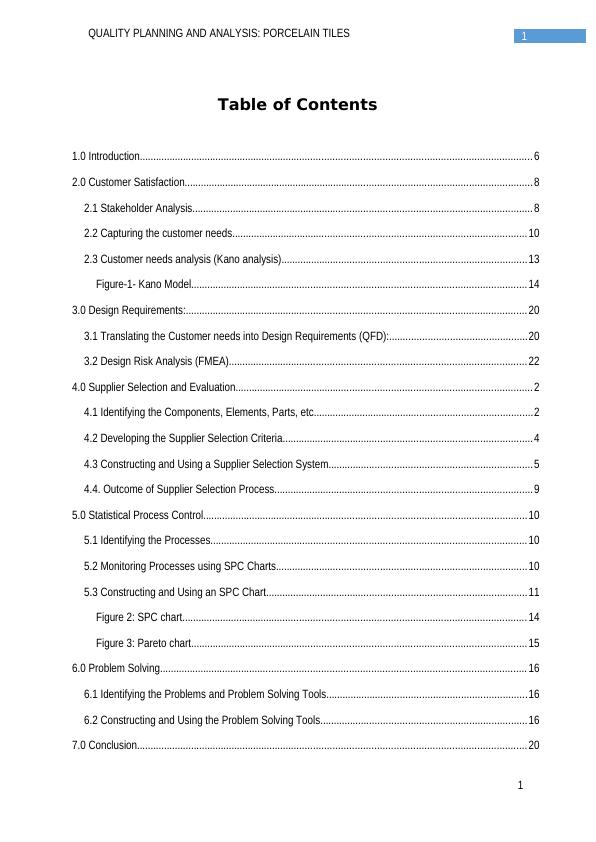
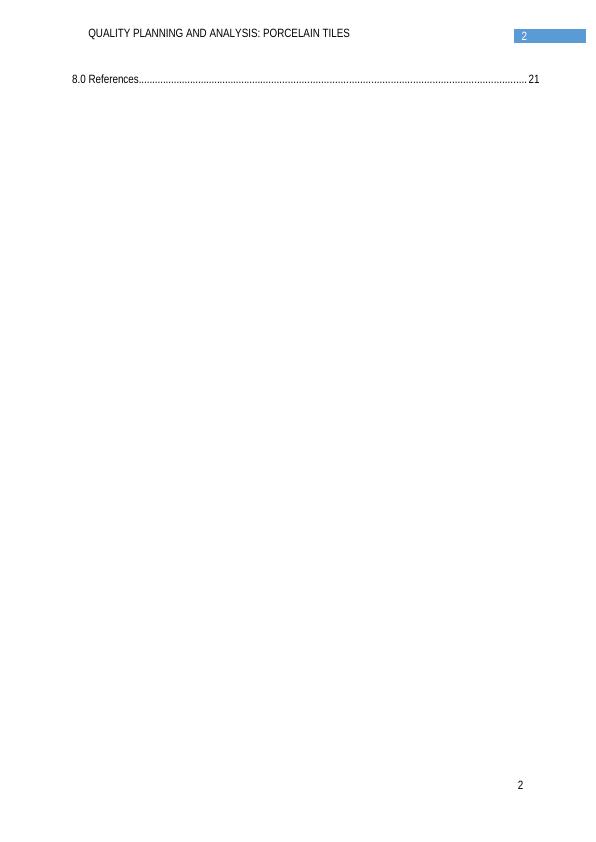
3QUALITY PLANNING AND ANALYSIS: PORCELAIN TILES
Table of Tables
Table-1- Stakeholder’s Analysis..................................................................................................................... 9
Table 2: questionnaire format.......................................................................................................................16
Table 3: data file........................................................................................................................................... 18
Table 4: category table................................................................................................................................. 18
Table 5: Correlation table............................................................................................................................. 20
Table 6: Relation with customer requirements..............................................................................................21
Table 7: Risk Analysis (FMEA)....................................................................................................................24
Table 8: SPC chart table...............................................................................................................................35
Table-9- Checklist.........................................................................................................................................36
3
Table of Tables
Table-1- Stakeholder’s Analysis..................................................................................................................... 9
Table 2: questionnaire format.......................................................................................................................16
Table 3: data file........................................................................................................................................... 18
Table 4: category table................................................................................................................................. 18
Table 5: Correlation table............................................................................................................................. 20
Table 6: Relation with customer requirements..............................................................................................21
Table 7: Risk Analysis (FMEA)....................................................................................................................24
Table 8: SPC chart table...............................................................................................................................35
Table-9- Checklist.........................................................................................................................................36
3
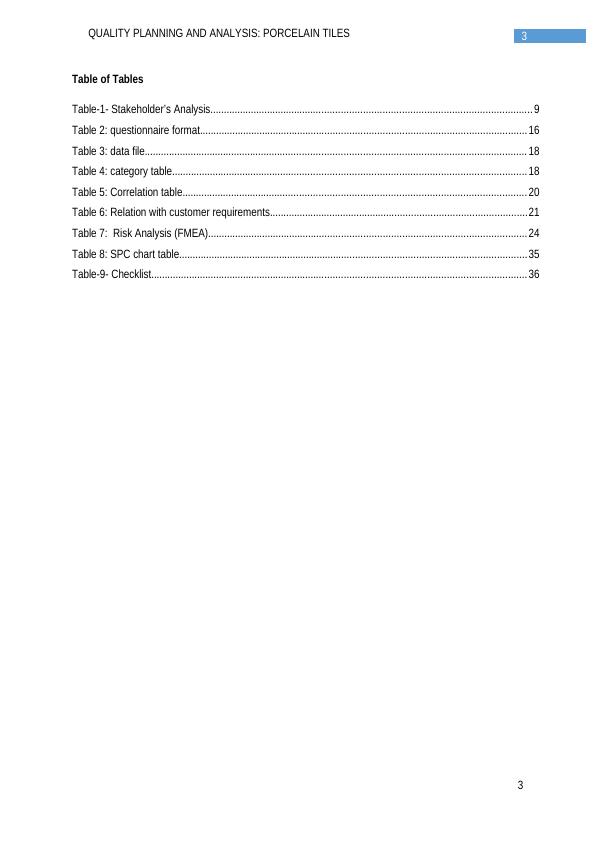
4QUALITY PLANNING AND ANALYSIS: PORCELAIN TILES
Table of Figure
Figure-1- Kano Model................................................................................................................................... 11
Figure 2: SPC chart...................................................................................................................................... 29
Figure 3: Pareto chart................................................................................................................................... 30
4
Table of Figure
Figure-1- Kano Model................................................................................................................................... 11
Figure 2: SPC chart...................................................................................................................................... 29
Figure 3: Pareto chart................................................................................................................................... 30
4
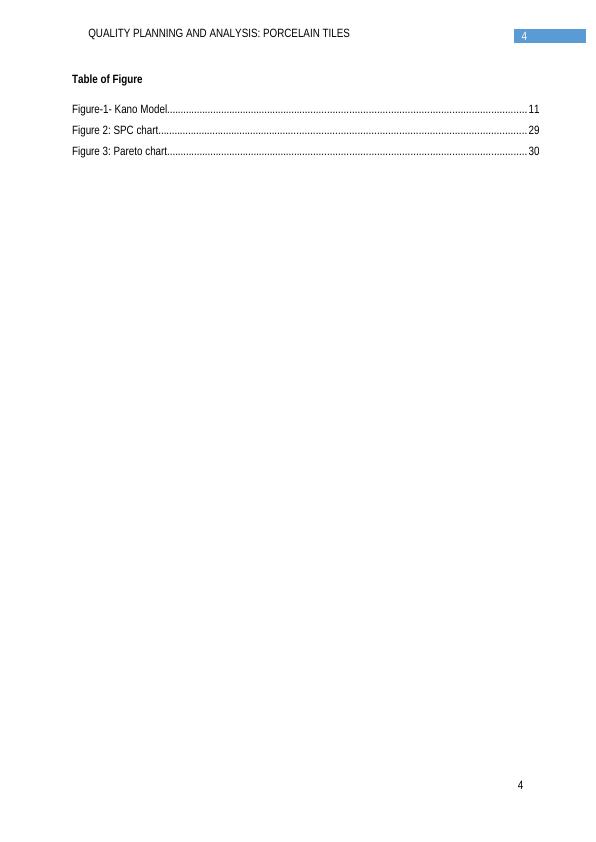
5QUALITY PLANNING AND ANALYSIS: PORCELAIN TILES
1.0 Introduction
The product chosen for this study is Porcelain.The product was initially produced only in North America
alone. Porcelain is made up of a blend of natural substances which as mineral based, such as sand,
clay, feldspar, talc and many others. Porcelain tile is pressed and put under flamein a furnace at high
temperatures to mold the product in whatever preferred shape. Therefore, drawing from this context, it
can be said that porcelain tileshave the characteristics of being fire resistant, non-combustible, long-
lasting and especially easy to preserve.
The Material constitution of tiles of porcelain are found to live up to the set quality standards of the
global market. Its durability is also found to be up to the global standards.These tiles global markets
and are also found to be easily available. They are thus widely used and additionally they serve a dual
role in their functionality as floor coverings and wall coverings. They not only meet their main functional
requirements of being building blocks but additionally are appreciated for the aesthetic quality they
make scope for. Thus they also act as a design component and hence serve to be building finishing
materials. As its role in being a building finishing material, tiles of porcelain are found to be able to
withstand various environmental stress factors.
Tiles of porcelain are primarily made up of ceramic. They are used in both commercial places and
residential buildings. Thiskind of tiles are widely used and can be found in countries all around the
world, however few countries such asItaly, China, India, and other countries around Asiahave turned
out to be its major users today. Presently, the notable countries China, Spain, Turkey and Italy among
all other producers of the product are the leaders of manufacturing Porcelain tiles.
Strength and Weakness
The characteristics that can be considered as its strengths are listed as below:
They are resistant to wearing and tearing.
Porcelain tiles have very high accessibility and durability.
Porcelain tiles are found to be especially useful in areas which are dry and are zones of low
traffic.
Porcelain tiles have a naturally glazed surface and thus not much efforts are not required in
polishing them in the manufacturing process.
5
1.0 Introduction
The product chosen for this study is Porcelain.The product was initially produced only in North America
alone. Porcelain is made up of a blend of natural substances which as mineral based, such as sand,
clay, feldspar, talc and many others. Porcelain tile is pressed and put under flamein a furnace at high
temperatures to mold the product in whatever preferred shape. Therefore, drawing from this context, it
can be said that porcelain tileshave the characteristics of being fire resistant, non-combustible, long-
lasting and especially easy to preserve.
The Material constitution of tiles of porcelain are found to live up to the set quality standards of the
global market. Its durability is also found to be up to the global standards.These tiles global markets
and are also found to be easily available. They are thus widely used and additionally they serve a dual
role in their functionality as floor coverings and wall coverings. They not only meet their main functional
requirements of being building blocks but additionally are appreciated for the aesthetic quality they
make scope for. Thus they also act as a design component and hence serve to be building finishing
materials. As its role in being a building finishing material, tiles of porcelain are found to be able to
withstand various environmental stress factors.
Tiles of porcelain are primarily made up of ceramic. They are used in both commercial places and
residential buildings. Thiskind of tiles are widely used and can be found in countries all around the
world, however few countries such asItaly, China, India, and other countries around Asiahave turned
out to be its major users today. Presently, the notable countries China, Spain, Turkey and Italy among
all other producers of the product are the leaders of manufacturing Porcelain tiles.
Strength and Weakness
The characteristics that can be considered as its strengths are listed as below:
They are resistant to wearing and tearing.
Porcelain tiles have very high accessibility and durability.
Porcelain tiles are found to be especially useful in areas which are dry and are zones of low
traffic.
Porcelain tiles have a naturally glazed surface and thus not much efforts are not required in
polishing them in the manufacturing process.
5

6QUALITY PLANNING AND ANALYSIS: PORCELAIN TILES
Porcelain tiles are easy to maintain.
A variety of style of porcelain tiles are easily available and that adds to the aesthetic allure for
consumers.
Porcelain tiles are resistant to moisture and are thus waterproof.
Cleaning is easy for porcelain tiles
Porcelain tiles are fireproof.
The characteristics that can be considered as its weakness are listed as below:
Tiles of porcelain are heavy and dense in nature making it challenging to transport and handle
them
Porcelain is expensive which may make some consumers reconsider and choose cheaper
options
Installation process can be challenging since it involves cutting the heavy and dense tiles into
shape
Chloride water and acids stains porcelain tiles and can make its color fade over time making its
appearance dull.
Porcelain as a substance has high density
It is a heavy material
Installation requires investment in additional materials such as grout.
6
Porcelain tiles are easy to maintain.
A variety of style of porcelain tiles are easily available and that adds to the aesthetic allure for
consumers.
Porcelain tiles are resistant to moisture and are thus waterproof.
Cleaning is easy for porcelain tiles
Porcelain tiles are fireproof.
The characteristics that can be considered as its weakness are listed as below:
Tiles of porcelain are heavy and dense in nature making it challenging to transport and handle
them
Porcelain is expensive which may make some consumers reconsider and choose cheaper
options
Installation process can be challenging since it involves cutting the heavy and dense tiles into
shape
Chloride water and acids stains porcelain tiles and can make its color fade over time making its
appearance dull.
Porcelain as a substance has high density
It is a heavy material
Installation requires investment in additional materials such as grout.
6
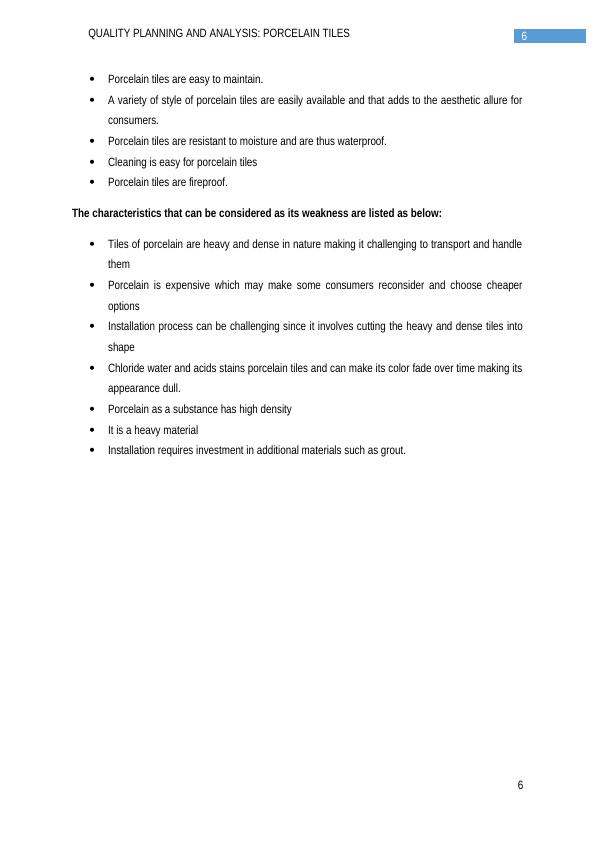
7QUALITY PLANNING AND ANALYSIS: PORCELAIN TILES
2.0 Customer Satisfaction
2.1 Stakeholder Analysis
Stakeholders have a major role to play in regulation and maintenance of the quality products no matter
what kind. Theseindividuals influence how and what goods are produced as per the production limits of
the manufacturers and this holds no matter what or who the company or firm is as per the production
abilities. The people who can be considered as the stakeholders include staffs, management agencies,
clients, investors, sponsors of the products in the market and even customers themselves (Jemmasi,
Strong and Taylor, 2011). They fuel the investmentbeing made for manufacturing and promotions to
improve the demand in the market. Moreover, shareholderswork to cause diversity in the growth and
theactivities reflecting expansion within a given time period of the organization. The stakeholders of an
organization contribute towardsstrategies of growth of the production and distribution framework and
other developmental strategies of the products. They do this by means ofcommunication to the world,
the pros and cons of whatever product they are associated with.
No. Stakeholder Expectations
1 Customer priced reasonably
Has Better design
Product is reliable
2 Investors Enhances the value of investors
Increases the organization’s profit margin.
3 Employees The work environment is safe and suitable
There is a training infrastructure in place to help employees improve
Bonus and incentive schemes are present
4 Retailers Higher level of sales margin achieved through distribution activities.
There are effective warranty schemes as well as responsive customer care
services in place
5 Direct Competitors Competition is fair
7
2.0 Customer Satisfaction
2.1 Stakeholder Analysis
Stakeholders have a major role to play in regulation and maintenance of the quality products no matter
what kind. Theseindividuals influence how and what goods are produced as per the production limits of
the manufacturers and this holds no matter what or who the company or firm is as per the production
abilities. The people who can be considered as the stakeholders include staffs, management agencies,
clients, investors, sponsors of the products in the market and even customers themselves (Jemmasi,
Strong and Taylor, 2011). They fuel the investmentbeing made for manufacturing and promotions to
improve the demand in the market. Moreover, shareholderswork to cause diversity in the growth and
theactivities reflecting expansion within a given time period of the organization. The stakeholders of an
organization contribute towardsstrategies of growth of the production and distribution framework and
other developmental strategies of the products. They do this by means ofcommunication to the world,
the pros and cons of whatever product they are associated with.
No. Stakeholder Expectations
1 Customer priced reasonably
Has Better design
Product is reliable
2 Investors Enhances the value of investors
Increases the organization’s profit margin.
3 Employees The work environment is safe and suitable
There is a training infrastructure in place to help employees improve
Bonus and incentive schemes are present
4 Retailers Higher level of sales margin achieved through distribution activities.
There are effective warranty schemes as well as responsive customer care
services in place
5 Direct Competitors Competition is fair
7

End of preview
Want to access all the pages? Upload your documents or become a member.
Related Documents
Customer Satisfaction and Design Requirements for Porcelain Tileslg...
|39
|7799
|464
Quality Planning and Analysis for Solar Roof Tiles - XYZ Companylg...
|37
|6776
|477
Quality Planning and Analysis for Power Generating Transformer Design and Maintenancelg...
|34
|7042
|312
Quality Planning Analysis for English Training at British Councillg...
|31
|5230
|425
Quality Planning & Analysis Assignmentlg...
|38
|8828
|64
Quality Planning and Analysislg...
|36
|8010
|92
